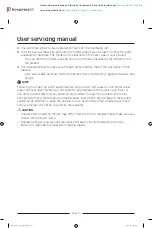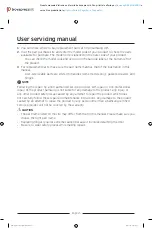
9
within the recommended time.
Butter can become tainted by strong smelling foods so it is best stored in a sealed container.
Eggs can be stored in the fridge compartment.
Red meat
Place fresh red meat on a plate and loosely cover with waxed paper, plastic
wrap or foil.
Store cooked and raw meat on separate plates. This will prevent any juice
lost from the raw meat from contaminating the cooked product.
Poultry
Fresh whole birds should be rinsed inside and out with cold running water,
dried and placed on a plate. Cover loosely with plastic wrap or foil.
Poultry pieces should also be stored this way. Whole poultry should never be
stuffed until just before cooking, otherwise food poisoning may result.
Cool and refrigerate cooked poultry quickly. Remove stuffing from poultry
and store separately.
Fish and seafood
Whole fish and fillets should be used on the day of purchase. Until required,
refrigerate on a plate loosely covered with plastic wrap, waxed paper or foil.
If storing overnight or longer, take particular care to select very fresh fish.
Whole fish should be rinsed in cold water to remove loose scales and dirt
and then patted dry with paper towels. Place whole fish or fillets in a sealed
plastic bag.
Keep shellfish chilled at all times. Use within 1 – 2 days.
Precooked foods and leftovers
These should be stored in suitable covered containers so that the food
will not dry out.
Keep for only 1 – 2 days.
Reheat leftovers only once and until steaming hot.
Vegetable and fresh fruit
The vegetable container is the optimum storage location for fresh fruit and
vegetables.
Take care not to store the following at temperatures of less than 7°C for
long periods:
Citrus fruit, melons, aubergines, pineapple, papaya, courgettes, passion
fruit, cucumber, peppers, tomatoes
Undesirable changes will occur at low temperatures such as softening of the flesh, browning and/or
accelerated decaying.
Do not refrigerate avocados (until they are ripe), bananas, mangoes.
Downloaded from www.vandenborre.be
















































